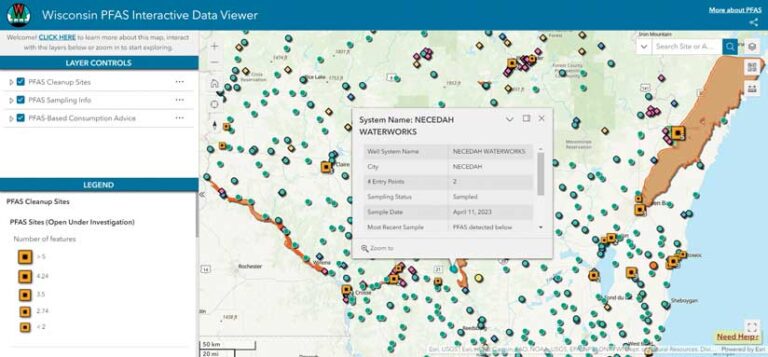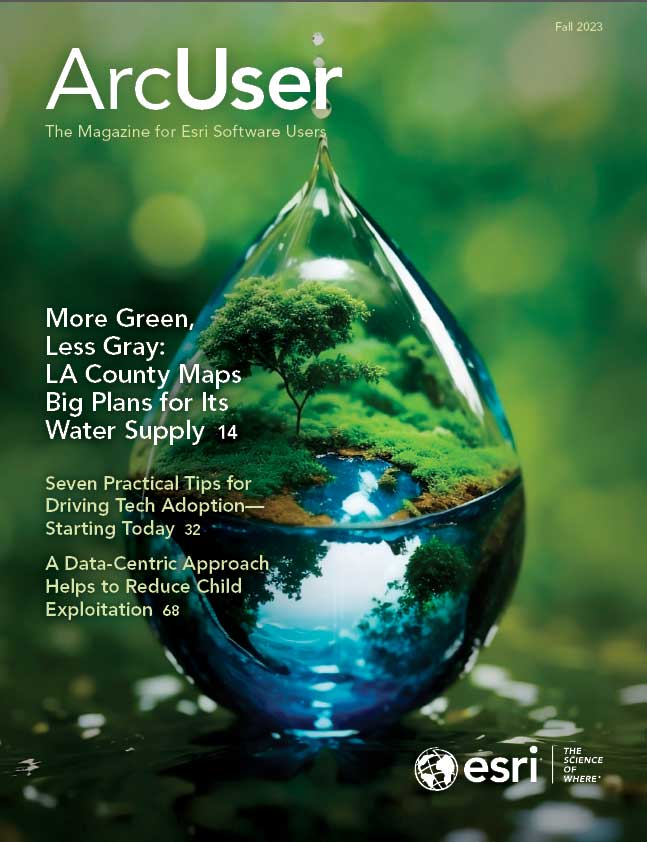Per- and polyfluoroalkyl substances (PFAS) are a group of synthetic chemicals found in everyday products such as food packaging, clothing, cosmetics, and toilet paper. They are called “forever chemicals” because they don’t break down in the environment or human bodies and have been linked to adverse health conditions that range from cancers to birth defects. According to a 2023 study by the US Geological Survey, 45 percent of US tap water is estimated to have one or more types of PFAS.
The thought of so-called forever chemicals coursing through bodies of water or across the Earth’s surface paints an ominous picture. Substantial efforts are now underway to combat PFAS, a notoriously pervasive class of contaminants.
The Wisconsin Department of Natural Resources (Wisconsin DNR) is mapping the prevalence of these dangerous chemicals in drinking water supplied by two of the world’s largest lakes, Lake Superior and Lake Michigan. Wisconsin DNR created a tool to capture levels of dangerous chemicals in the water and guide remediation efforts.
“We all have PFAS in our blood at this point,” said Melanie Johnson, director of the Office of Emerging Contaminants at Wisconsin DNR. “We’re all kind of dealing with it.”
Since the 1940s, toxic chemicals have been used to create a multitude of industrial and consumer products, including firefighting foam and household cleaners. PFAS have traveled through water systems, poisoning wildlife and people. Health-care professionals have tied these chemicals to liver and immune system issues in both humans and animals. Researchers continue to study the damaging effects of long-term exposure.
As the understanding of the risks associated with PFAS continues to grow, governments around the world are sampling water and mapping PFAS concentrations using GIS. The maps created show the areas that need to be targeted to address the presence of these enduring chemicals.
After Wisconsin DNR identified PFAS contamination levels that exceeded health recommendations in five communities, staff began implementing measures to address the problem. Spearheaded by Johnson and her colleague Jesse Papez, supervisor for the GIS Data Analysis and Integration section, Wisconsin DNR developed the Wisconsin PFAS Interactive Data Viewer to visualize the occurrence of PFAS across the state.
“PFAS have been around for almost 100 years,” Johnson said. “Two or three years ago, there were about 3,000 chemicals that we knew about, and now we’re at 10,000. We’re learning something new every day—learning how they behave in the environment, and how they impact our health. We’re starting to understand a lot more about the science behind them and what we can do to mitigate their impact.”

Addressing PFAS in the Water Worldwide
Companies that create and use PFAS are under intense scrutiny. They also face lawsuits for contributing to water pollution. The European Union has proposed a ban on the production, use, and sale of about 10,000 of these substances. In Japan, the government focused on improving water quality after a group of residents in Okinawa had high levels of PFAS in their blood. Recently, the US Environmental Protection Agency (EPA) proposed the first-ever national drinking water standard for six PFAS.
With the recent funding, the EPA plans to help communities on the front line of the fight against forever chemicals.
Wisconsin is one of several Great Lakes states that have made PFAS a priority in keeping their residents and abundant water resources safe. Because more than 1.6 million Wisconsin residents depend on Lake Superior and Lake Michigan for their drinking water, lowering PFAS levels has become a critical health priority. To this end, Wisconsin is increasing water testing, setting clear standards, and openly sharing its progress.
For Johnson and her team, GIS provides a better view of PFAS pollution and the health of water systems that are contaminated and most in need of ongoing cleanup.
“I think there’s great value in visualizing it,” Johnson said. “One of the things we really wanted to visualize is the drinking water results.”
Communicating and Collaborating
With the help of the PFAS data viewer, the Wisconsin DNR team can map contamination sites as well as locations where remediation efforts are underway. By visualizing and integrating this extensive location-based data, the team can effectively plan strategies, allocate resources, and share information.
Initially, Wisconsin DNR focused on remediation sites, while conducting statewide sampling of surface water and wastewater treatment plants. DNR staff wants to broaden the understanding of fish and wildlife contamination by sharing data and collaborating with neighboring states.
“If we’re studying a specific fish, we share that data with the other states and they share their data,” Johnson said.
Wisconsin DNR led the effort to study the smelt found in Lake Superior and issued a public advisory not to eat more than one meal of fish per month due to high levels of PFAS. That finding was confirmed by studies conducted in Michigan and Minnesota, and those states followed up with their own warnings.
One of Wisconsin DNR’s primary objectives is to ensure effective communication with the public. Through the Wisconsin PFAS Interactive Data Viewer, the team aims to provide a user-friendly interface for essential information. Anyone can navigate the PFAS data viewer to determine if there is any contamination within an area. Stakeholders, including those interested in detailed raw data or the history of a contaminated site, can delve deeper.
“We had a design goal of keeping it as intuitive as possible, yet as information rich as possible so the learning curve would be minimal,” Papez said, adding that the goal included “providing as much data as we could without it being overwhelming or requiring data science skills.”
Bridging the Divide
Wisconsin DNR recently received funds from the Infrastructure Investment and Jobs Act to address emerging contaminants and ensure excellent water quality. Johnson and her team believe that tools like the Wisconsin PFAS Interactive Data Viewer will play a crucial role in gaining stakeholder support to tackle PFAS, not only at the state level but also nationally.
“This tool can be very helpful for legislators to understand if PFAS contamination has been detected in their districts and how it impacts their constituents,” Johnson said. “As more communities witness the impact of PFAS, it will become more of a unifying issue.”
In the US, the Great Lakes states have been quick to act on PFAS, given their role as stewards of 95 percent of the fresh surface water in North America. More states are taking on this problem, starting with testing, and putting test results on a map. As PFAS contamination becomes more understood and strategies emerge, maps will be central to the worldwide cleanup effort.
Continued sampling will improve understanding about the need to reduce PFAS contamination levels and break the cycle of forever chemicals.





